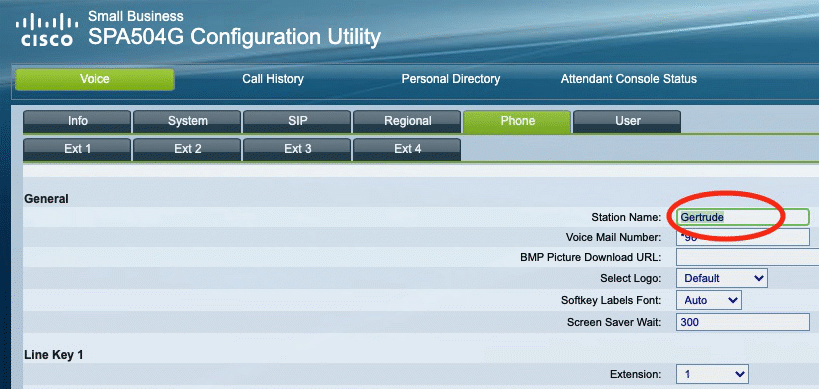Basic functions of the SPA504G phone
The following guide introduces the basic features of SPA504G telephones.
Changing the display name
Before following the steps below, make sure your phone is connected to the same network as your computer. To configure options, press the round silver button in the middle of your phone.
Important: You cannot apply changes while you are using the phone for a call.
Steps :
- Press the Setting
button.
- Select option 9 (Network).
- Your phone’s IP address will be on the second line (e.g., 192.168.X.X ou 10.1.X.X). Write it down.
- Open your internet browser (Chrome, Firefox, Safari, etc.) and type your phone’s IP address in the search bar. This should bring up a Cisco configuration page.
- Click the Admin Login button in the top right corner.
- Click the Advanced button.
- Click the Voice icon in the top left corner.
- Select the Phone tab.
- Change the Station Name at the top of the page by typing in the display name you want to use.
- To apply the changes, click the Submit All Changes button at the bottom of the page.
- The phone will reboot and display the new name.

Station Name option
Using phone equipment and accessories
Using the speakerphone
To use the speakerphone, press Speaker (the handset can be either on or off hook).
Using a headset with your IP phone
To use a wired headset, press Headset on your phone and dial the number to place a call, or press Headset to answer a ringing call.
To use a wireless headset, lift the handset off hook before speaking or listening through the headset.

Phone buttons (Speaker, Headset, Mute)
Switching between the handset, headset, and speakerphone during a call
The headset, handset and speaker phone can be used during a call, but only one of these devices can be used at a time.
The handset can be on hook when using the Speaker or Headset function. If switching from the handset to the speakerphone, make sure the speakerphone light is illuminated before placing the handset back on the hook. If you are switching from the handset to a wireless headset, do not replace the handset or you will disconnect the call.
Adjusting volume and using Mute

Volume button
Adjusting call volume
To adjust the volume of the handset or speaker, lift the handset or press the Speaker button. Press + on the Volume button to increase the volume, or press – to decrease the volume. Press Save.
Adjusting the ringer volume
To adjust the ringer volume, hang up the handset and make sure the speaker button is off. Press + on the Volume button to increase the volume, or press - to decrease the volume. Press Save.
Using Mute
To mute the handset, speaker and headset microphones, press Mute. The button lights red. Press Mute again to unmute.
If no audio device is on, pressing Mute has no effect. When switching from the speaker phone to the handset, the phone is unmuted automatically.
Answering or placing a call
To answer or place a call, do one of the following:
- Pick up the handset.
- Press Speaker.
- Press Headset.
- Press a green line button (to place a call) or blinking red line button (to answer a call).
If you are on a call and another call comes in, press the flashing red line button to place the current call on hold and answer the incoming call.
To return to the first call, press the line button for the call.
Putting a call on hold
To put an active call on hold, press the Hold button.
Music plays for the caller on hold to indicate that the call is on hold. Only one call can be active at a time. The Hold button places the active call on hold.

Hold button
Resuming a call
To resume the call that has been put on hold, press the flashing red line button for the call.
Ending a call
To end a call:
- If you are using the handset, hang up.
- If you are using the speakerphone, press Speaker.
- If you are using a headset, press Headset (wired) or replace the handset (wireless).
- Appuyez sur un bouton de ligne vert (pour passer un appel) ou émettant une lumière rouge clignotante (pour répondre à un appel).
Transferring a call
You can perform two types of transfers:
- Attended : Call the person to whom you are transferring the call and:
- make the transfer while the phone is ringing, or
- wait to speak with the person before transferring the call/li>
- Blind : Transfer the call without speaking to the other party to whom you are transferring the call
Attended transfer
- During an active call, press Xfer. The call is placed on hold and a new line is opened to dial the number.
- Do one of the following:
- Enter the number to which you want to transfer the call, then press Dial or wait a few seconds.
- Press Dir and either choose a number from the personal directory or select New Entry and press Dial. If you hang up before the second call rings, the transfer fails, and the first call is disconnected. If you misdial, use the DelChar, Clear, or Cancel key to make your changes before the call is transferred.
- Press Xfer after the phone begins to ring, or at any time after the phone is answered
Blind transfer
- During an active call, press the bXfer softkey.
- Enter the number to which you want to transfer the call and press Dial. The call is transferred with no further action required on your part.
Transferring a held call to an active call
If you have one call on hold and one active call, you can transfer one of the calls to the other call, connecting the two callers. This is different from a conference call, because you no longer remain part of the call after the transfer. With one active call and one or more calls on hold, press the XferLx softkey.
- If you have only one call on hold, the call is transferred to the active party and you are disconnected.
- If you have more than one call on hold, choose the held call you want to transfer by pressing the line button of the call on hold.
Redialling a number
To redial the last number dialled, press the Redial button twice.
To redial another number:
- Press the Redial softkey and select the desired number from the redial list
- (Optional) It might be necessary to edit the number to add a prefix or area code. Press Edit and use the softkey buttons to edit a number. When you are finished, press Ok.
- Lift the handset or press Dial to dial the selected number.
Viewing and returning missed calls
Your IP phone’s screen notifies you if a call came in and was unanswered.
To view and return a missed call:
- If the IP phone screen shows a missed call, press the Lcr softkey to return the missed call. Press the Miss softkey to view a list of missed calls, select a call, and press Dial.
- If the screen does not show a missed call, you can return a call from the missed calls list:
- Press the Setup button.
- Select Call History.
- Select Missed Calls.
- Select the call you want to return and press Dial.
Forwarding calls
- Press the Cfwd softkey.
- Enter the number to which you would like to forward your calls—for example, your voicemail box, another extension or an outside line. If forwarding calls to an outside line, be sure to use any steering digits, access codes, or area codes required to complete the call.
- Press Dial. The IP phone screen displays calls forwarded
To stop call forwarding, press the -Cfwd softkey.
Setting up Do Not Disturb
Use the Do Not Disturb feature to prevent incoming calls from ringing your phone. If you have voicemail configured, incoming callers can be immediately routed to voicemail. If voicemail is not configured, callers will hear a busy signal or a message stating that the line is busy.
- To Activate Do Not Disturb mode, press the Dnd softkey. The IP phone screen indicates that Do Not Disturb is turned on for your phone.
- To Disable Do Not Disturb mode, press the -Dnd softkey.
Parking a call
You can park a call on a designated line so that another person in your company can pick up the call. The call is active until it is unparked or the caller hangs up.
To park a call
- While on an active call, press a green line button.
- Press the Park softkey or dial *68
- Listen for the virtual operator to announce the parking number. It will be a number from 1 to 30.
- Press the XferLx softkey.
NOTE : A call parked for more than 90 seconds will be automatically transferred back to the number that parked it.
Resuming a parked call
You or another user will then be able to resume the parked call from any telephone in your organization. To do so:
- Pick up the handset.
- Press a green line button.
- Enter *x, where “x” corresponds to the parking number, followed by #.
- For example, dial *1# to pick up the parked call in the first parking position.
Placing a three-way conference call
You can start conference calls by:
- Pressing the Conf softkey during an active call. The first call is placed on hold, a second line is opened, and you hear a dial tone.
- Dial the second telephone number.
- Press the Conf softkey again. All three parties are connected in the conference call.
NOTE : When you hang up, the other two parties are disconnected.
Conferencing a held call with an active call
If you have a call on hold and an active call, you can create a conference call that includes yourself, the active call and the call on hold.
With an active call and one or more calls on hold, press the ConfLx softkey.
- If you have only one call on hold, the conference call is created between the three of you.
- If you have more than one call on hold, choose the held call you want to conference in by pressing the line button of the call on hold.
Accessing voicemail
To access voicemail, press the Messages button on your phone.

Messages button






